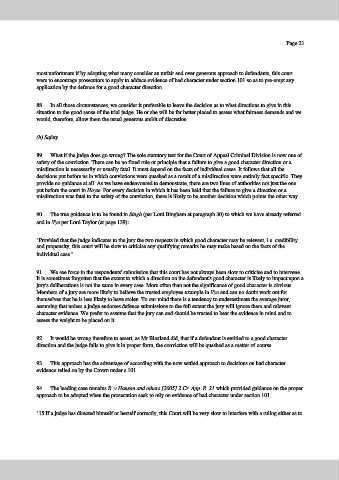Page 430 - Magistrates Conference 2019
P. 430
Page 23
most unfortunate if by adopting what many consider an unfair and over generous approach to defendants, this court
were to encourage prosecutors to apply to adduce evidence of bad character under section 101 so as to pre-empt any
application by the defence for a good character direction.
88. In all those circumstances, we consider it preferable to leave the decision as to what directions to give in this
situation to the good sense of the trial judge. He or she will be far better placed to assess what fairness demands and we
would, therefore, allow them the usual generous ambit of discretion.
(h) Safety
89. What if the judge does go wrong? The sole statutory test for the Court of Appeal Criminal Division is now one of
safety of the conviction. There can be no fixed rule or principle that a failure to give a good character direction or a
misdirection is necessarily or usually fatal. It must depend on the facts of individual cases. It follows that all the
decisions put before us in which convictions were quashed as a result of a misdirection were entirely fact specific. They
provide no guidance at all. As we have endeavoured to demonstrate, there are two lines of authorities not just the one
put before the court in Hoyte. For every decision in which it has been held that the failure to give a direction or a
misdirection was fatal to the safety of the conviction, there is likely to be another decision which points the other way.
90. The true guidance is to be found in Singh (per Lord Bingham at paragraph 30) to which we have already referred
and in Vye per Lord Taylor (at page 139):
"Provided that the judge indicates to the jury the two respects in which good character may be relevant, i.e. credibility
and propensity, this court will be slow to criticise any qualifying remarks he may make based on the facts of the
individual case."
91. We see force in the respondents' submission that this court has not always been slow to criticise and to intervene.
It is sometimes forgotten that the extent to which a direction on the defendant's good character is likely to impact upon a
jury's deliberations is not the same in every case. More often than not the significance of good character is obvious.
Members of a jury are more likely to believe the trusted employee example in Vye and can no doubt work out for
themselves that he is less likely to have stolen. To our mind there is a tendency to underestimate the average juror,
assuming that unless a judge endorses defence submissions to the full extent the jury will ignore them and relevant
character evidence. We prefer to assume that the jury can and should be trusted to bear the evidence in mind and to
assess the weight to be placed on it.
92. It would be wrong therefore to assert, as Mr Blaxland did, that if a defendant is entitled to a good character
direction and the judge fails to give it in proper form, the conviction will be quashed as a matter of course.
93. This approach has the advantage of according with the now settled approach to decisions on bad character
evidence relied on by the Crown under s 101.
94. The leading case remains R. v Hanson and others [2005] 2 Cr. App. R. 21 which provided guidance on the proper
approach to be adopted when the prosecution seek to rely on evidence of bad character under section 101.
"15 If a judge has directed himself or herself correctly, this Court will be very slow to interfere with a ruling either as to

